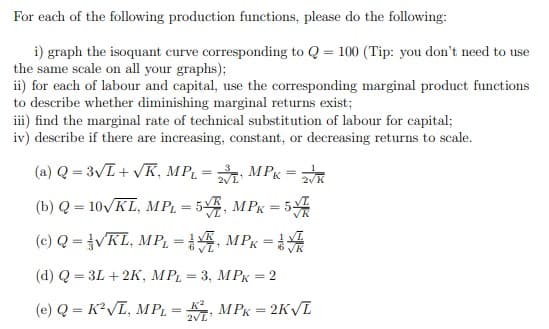For each of the following production functions, please do the following: i) graph the isoquant curve corresponding to Q = 100 (Tip: you don't need to use the same scale on all your graphs); ii) for each of labour and capital, use the corresponding marginal product functions to describe whether diminishing marginal returns exist; iii) find the marginal rate of technical substitution of labour for capital; iv) describe if there are increasing, constant, or decreasing returns to scale.
For each of the following production functions, please do the following: i) graph the isoquant curve corresponding to Q = 100 (Tip: you don't need to use the same scale on all your graphs); ii) for each of labour and capital, use the corresponding marginal product functions to describe whether diminishing marginal returns exist; iii) find the marginal rate of technical substitution of labour for capital; iv) describe if there are increasing, constant, or decreasing returns to scale.
Microeconomics A Contemporary Intro
10th Edition
ISBN:9781285635101
Author:MCEACHERN
Publisher:MCEACHERN
Chapter7: Production And Cost In The Firm
Section7.A: Appendix: A Closer Look At Production And Cost
Problem 1AQ
Related questions
Question
Please answer this question in few hours please. Thanks.

Transcribed Image Text:For each of the following production functions, please do the following:
i) graph the isoquant curve corresponding to Q = 100 (Tip: you don't need to use
the same scale on all your graphs);
ii) for each of labour and capital, use the corresponding marginal product functions
to describe whether diminishing marginal returns exist;
iii) find the marginal rate of technical substitution of labour for capital;
iv) describe if there are increasing, constant, or decreasing returns to scale.
(a) Q = 3√L+ √K, MPL = 2 MPK = 2√/K
L'
(b) Q = 10√/KL, MPL = 5V, MPK = 5
(c) Q = VKL, MP₁ =
MPK =
(d) Q = 3L + 2K, MPL = 3, MPK = 2
(e) Q = K²√L, MPL = K2, MPK = 2K√L
1
Expert Solution
This question has been solved!
Explore an expertly crafted, step-by-step solution for a thorough understanding of key concepts.
This is a popular solution!
Trending now
This is a popular solution!
Step by step
Solved in 4 steps with 3 images

Knowledge Booster
Learn more about
Need a deep-dive on the concept behind this application? Look no further. Learn more about this topic, economics and related others by exploring similar questions and additional content below.Recommended textbooks for you


Managerial Economics: Applications, Strategies an…
Economics
ISBN:
9781305506381
Author:
James R. McGuigan, R. Charles Moyer, Frederick H.deB. Harris
Publisher:
Cengage Learning



Managerial Economics: Applications, Strategies an…
Economics
ISBN:
9781305506381
Author:
James R. McGuigan, R. Charles Moyer, Frederick H.deB. Harris
Publisher:
Cengage Learning



Exploring Economics
Economics
ISBN:
9781544336329
Author:
Robert L. Sexton
Publisher:
SAGE Publications, Inc

Microeconomics: Principles & Policy
Economics
ISBN:
9781337794992
Author:
William J. Baumol, Alan S. Blinder, John L. Solow
Publisher:
Cengage Learning